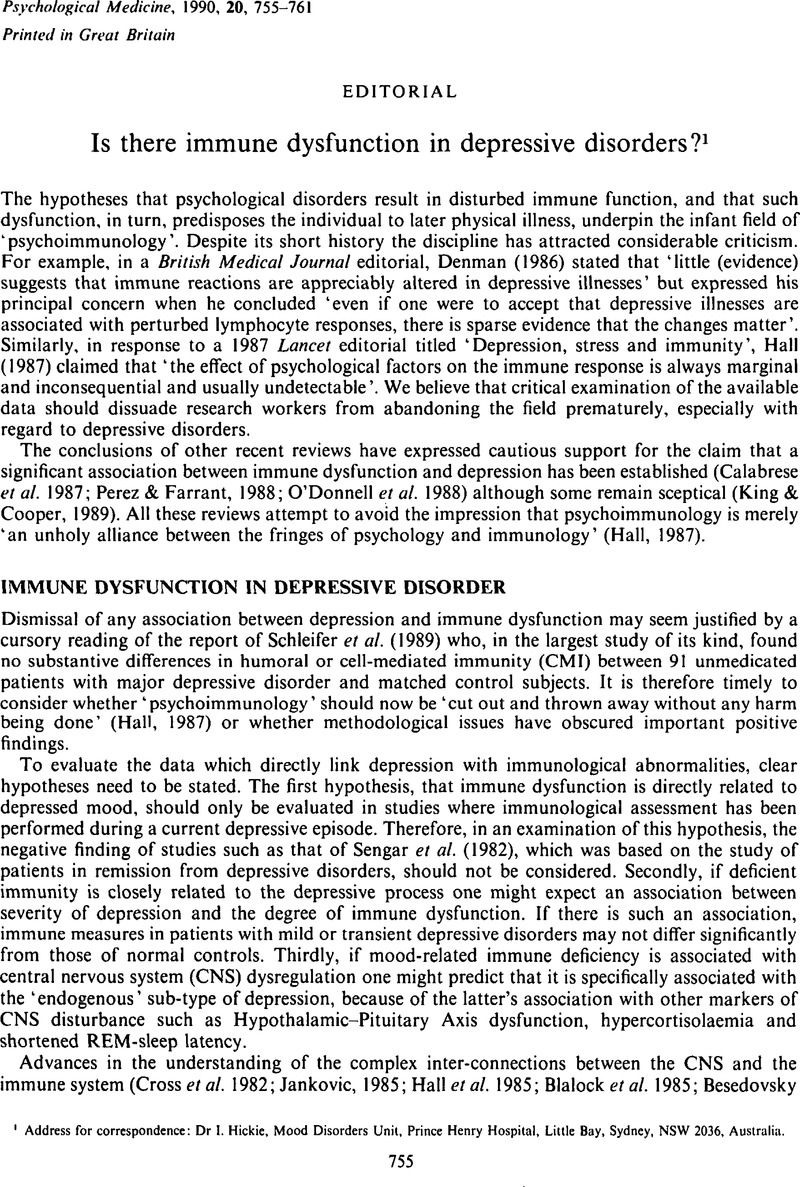Crossref Citations
This article has been cited by the following publications. This list is generated based on data provided by Crossref.
Hickie, Ian
Lloyd, Andrew
and
Wakefield, Denis
1991.
Chronic fatigue syndrome and depression.
The Lancet,
Vol. 337,
Issue. 8746,
p.
922.
Hickie, Ian
Lloyd, Andrew
and
Wakefield, Denis
1992.
Immunological and Psychological Dysfunction in Patients Receiving Immunotherapy for Chronic Fatigue Syndrome.
Australian & New Zealand Journal of Psychiatry,
Vol. 26,
Issue. 2,
p.
249.
Neveu, P.J.
1992.
Asymmetrical brain modulation of immune reactivity in mice: A model for studying interindividual differences and physiological population heterogeneity?.
Life Sciences,
Vol. 50,
Issue. 1,
p.
1.
Hickie, Ian
Hickie, Catherine
Lloyd, Andrew
Silove, Derrick
and
Wakefield, Denis
1993.
ImpairedIn VivoImmune Responses in Patients with Melancholia.
British Journal of Psychiatry,
Vol. 162,
Issue. 5,
p.
651.
Watson, I Patrick Burges
Muller, H Konrad
Jones, Ivor H
and
Bradley, Adrian J
1993.
Cell‐mediated immunity in combat veterans with post‐traumatic stress disorder.
Medical Journal of Australia,
Vol. 159,
Issue. 8,
p.
513.
Lloyd, Andrew
Hickie, Ian
Wilson, Andrew
and
Wakefield, Denis
1994.
Immune Function in Chronic Fatigue Syndrome and Depression.
Clinical Immunotherapeutics,
Vol. 2,
Issue. 2,
p.
84.
Bauer, Moisés E.
Gauer, Gabriel J.
Luz, Clarice
Silveira, Ricardo O.
Nardi, Nance B.
and
von Mühlen, Carlos A.
1995.
Evaluation of immune parameters in depressed patients.
Life Sciences,
Vol. 57,
Issue. 7,
p.
665.
Pariante, Carmine M
and
Miller, Andrew H
1995.
Natural killer cell activity in major depression: a prospective study of the in vivo effects of desmethylimipramine treatment.
European Neuropsychopharmacology,
Vol. 5,
Issue. ,
p.
83.
Hickie, Catherine
Hickie, Ian
Silove, Derrick
Wakefield, Denis
and
Lloyd, Andrew
1995.
Delayed-type hypersensitivity skin testing: Normal values in the Australian population.
International Journal of Immunopharmacology,
Vol. 17,
Issue. 8,
p.
629.
Hickie, Ian
Hickie, Catherine
Bennett, Barbara
Wakefield, Denis
Silove, Derrick
Mitchell, Philip
and
Lloyd, Andrew
1995.
Biochemical correlates of in vivo cell-mediated immune dysfunction in patients with depression: A preliminary report.
International Journal of Immunopharmacology,
Vol. 17,
Issue. 8,
p.
685.
Brown, S.Lori
Salive, Marcel E.
Guralnik, Jack M.
Wallace, Robert B.
Ostfeld, Adrian M.
and
Blazer, Dan
1995.
Depressive symptoms in the elderly: Association with total white blood cell count.
Progress in Neuro-Psychopharmacology and Biological Psychiatry,
Vol. 19,
Issue. 5,
p.
849.
Spratt, Evelyn Lyn
and
Hewson, Daphne
1996.
School experience of adolescents with chronic fatigue syndrome.
Australian Journal of Guidance and Counselling,
Vol. 6,
Issue. 1,
p.
73.
Hickie, Ian
Bennett, Barbara
Mitchell, Philip
Wilhelm, Kay
and
Orlay, Wendy
1996.
Clinical and Subclinical Hypothyroidism in Patients with Chronic and Treatment-Resistant Depression.
Australian & New Zealand Journal of Psychiatry,
Vol. 30,
Issue. 2,
p.
246.
Sredni, D.
1997.
Chronic Fatigue Syndrome.
p.
131.
Tjemsland, Lars
Søreide, Jon Arne
Matre, Roald
and
Malt, Ulrik Fredrik
1997.
Properative psychological variables predict immunological status in patients with operable breast cancer.
Psycho-Oncology,
Vol. 6,
Issue. 4,
p.
311.
Koh, Kyung Bong
1998.
Emotion and immunity.
Journal of Psychosomatic Research,
Vol. 45,
Issue. 2,
p.
107.
Neveu, Pierre J.
and
Castanon, Nathalie
1999.
Cytokines, Stress, and Depression.
Vol. 461,
Issue. ,
p.
267.
Smith, Alison
Vollmer-Conna, Ute
Bennett, Barbara
Wakefield, Denis
Hickie, Ian
and
Lloyd, Andrew
2004.
The relationship between distress and the development of a primary immune response to a novel antigen.
Brain, Behavior, and Immunity,
Vol. 18,
Issue. 1,
p.
65.
Blake Mortimer, Jane S.
Sephton, Sandra E.
Kimerling, Rachel
Butler, Lisa
Bernstein, Aaron S.
and
Spiegel, David
2005.
Chronic stress, depression and immunity in spouses of metastatic breast cancer patients.
Clinical Psychologist,
Vol. 9,
Issue. 2,
p.
59.
Ronchetti, Ramiro
Dal Pizzol, Mariana
Lopes, Rodrigo Pestana
Silva, Rachel Rubin da
Gauer, Gabriel José Chittó
and
Bauer, Moisés Evandro
2007.
Paroxetine and bupropion have no in vitro effects on lynphocyte proliferation and viability.
Jornal Brasileiro de Psiquiatria,
Vol. 56,
Issue. 2,
p.
116.



